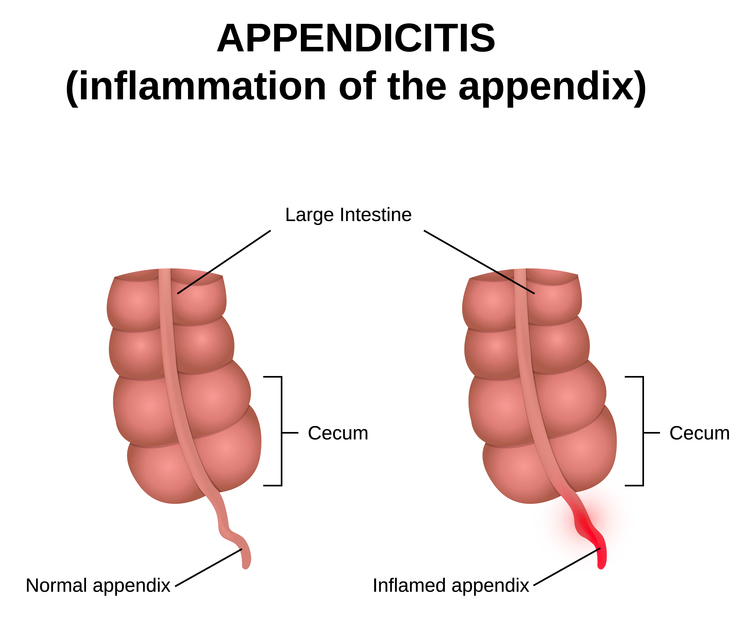Appendicitis: Symptoms, Causes & Treatment
What are the symptoms of appendicitis?
Appendicitis is the inflammation of the appendix, a small, finger-like projection on the lower right side of the abdomen. It’s considered a medical emergency, and prompt treatment is essential to prevent complications such as rupture. The symptoms of appendicitis can vary but typically include:
- Abdominal pain: The classic symptom is sudden pain that begins around the navel (belly button) and then shifts to the lower right abdomen. This pain usually becomes sharp and severe as the inflammation worsens.
- Appetite loss
- Nausea and vomiting: These symptoms often occur after the onset of abdominal pain.
- Abdominal swelling
- Fever: A low-grade fever that may worsen as the condition progresses.
- Inability to pass gas
- Constipation or diarrhea: Bowel movements may be affected due to the inflammation in the abdomen.
- Rebound tenderness: Pain that gets worse upon releasing pressure rather than applying it on the lower right side of the abdomen.
- Painful urination: In some cases, if the appendix lies near the bladder.
- A general feeling of being unwell
It’s important to consult a healthcare provider if you or someone you know experiences symptoms that might indicate appendicitis. The condition can quickly progress, and an untreated inflamed appendix can burst, releasing bacteria into the abdominal cavity, leading to serious complications. Diagnosis typically involves a physical exam, blood tests to check for signs of infection, and imaging tests such as an ultrasound or CT scan to confirm the diagnosis.
What are the causes of appendicitis?
Appendicitis is primarily caused by an obstruction or blockage in the appendix, which is a small, pouch-like structure attached to the first part of the large intestine. This obstruction can lead to inflammation, infection, and potentially rupture of the appendix. Some of the common causes of appendicitis include:
- Fecal matter (stool): The most common cause of appendicitis is an obstruction by fecal matter that gets trapped in the appendix, leading to inflammation and infection.
- Lymphoid tissue: The appendix is made up of lymphoid tissue, which can swell and cause obstruction, especially during viral or bacterial infections.
- Gastrointestinal issues: Conditions that affect the digestive system, such as Crohn’s disease, ulcerative colitis, or intestinal infections, can increase the risk of appendicitis.
- Trauma: Abdominal injuries or trauma, while not a common cause, can potentially lead to appendicitis by causing damage or obstruction to the appendix.
- Foreign bodies: In rare cases, foreign bodies, such as seeds, pieces of food, or other small objects, can become trapped in the appendix and cause obstruction.
- Tumors or growths: Rarely, tumors or growths in the appendix or surrounding areas can cause obstruction and lead to appendicitis.
- Genetic factors: Some studies suggest that there may be a genetic predisposition to appendicitis in certain individuals or families.
While appendicitis can occur at any age, it is most common in people between the ages of 10 and 30 years old. Certain factors, such as a low-fiber diet, dehydration, and a family history of appendicitis, may increase the risk of developing the condition.
It’s important to note that appendicitis is a medical emergency, and prompt treatment is necessary to prevent complications, such as rupture of the appendix, which can lead to a potentially life-threatening infection called peritonitis.
What are the treatments for appendicitis?
The main treatment for appendicitis is surgery to remove the inflamed appendix, a procedure called an appendectomy. The specific treatment approach depends on the severity of the condition and the presence of any complications. The treatments for appendicitis include:
- Appendectomy (surgical removal of the appendix):
- Open appendectomy: This traditional surgical method involves making an incision in the lower right abdomen to remove the appendix.
- Laparoscopic appendectomy: This minimally invasive technique uses small incisions and a tiny camera (laparoscope) to guide the removal of the appendix.
- Antibiotics: In some cases, such as in patients with an appendix mass or abscess, antibiotics may be given initially to help control the infection before proceeding with surgery.
- Drainage of abscess: If an abscess (pus-filled pocket) has formed due to a ruptured appendix, a procedure called percutaneous drainage may be performed to drain the abscess before surgery.
- Treatment of peritonitis: If the appendix has ruptured and caused peritonitis (inflammation of the abdominal lining), more extensive treatment may be required, including:
- Intravenous (IV) antibiotics to control the infection
- Surgical removal of the appendix and cleaning of the abdominal cavity
- Temporary placement of a drain to allow the infected fluid to drain
- Supportive care: Depending on the severity of the condition, supportive care may include:
- Pain medication
- Intravenous (IV) fluids for hydration
- Nasogastric tube (a tube inserted through the nose into the stomach) to decompress the stomach
In most cases, an appendectomy is the primary treatment for appendicitis, and it can be performed as an emergency surgery or as a planned procedure, depending on the patient’s condition. Early treatment is crucial to prevent complications such as rupture, peritonitis, and potential life-threatening infections.
After surgery, patients typically require a brief hospital stay for observation and recovery, followed by a period of rest and a gradual return to normal activities.




